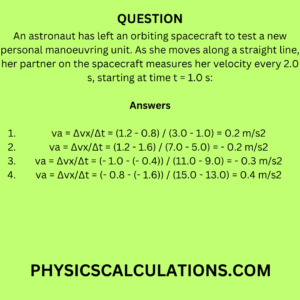Question
An astronaut has left an orbiting spacecraft to test a new personal manoeuvring unit. As she moves along a straight line, her partner on the spacecraft measures her velocity every 2.0 s, starting at time t = 1.0 s:
| t | vx | t | vx |
| 1.0 s | 0.8 m/s | 9.0 s | – 0.4 m/s |
| 3.0 s | 1.2 m/s | 11.0 s | – 1.0 m/s |
| 5.0 s | 1.6 m/s | 13.0 s | – 1.6 m/s |
| 7.0 s | 1.2 m/s | 15.0 s | – 0.8 m/s |
Find the average x-acceleration, and state whether the speed of the astronaut increases or decreases, for each of these time intervals:
a. t1 = 1.0 s to t2 = 3.0 s
b. t1 = 5.0 s to t2 = 7.0 s
c. t1 = 9.0 s to t2 = 11.0 s
d. t1 = 13.0 s to t2 = 15.0 s
Solution

a)
When we look at the table, we will see that at t1 = 1.0 s we have vx = 0.8 m/s
Additionally, at t2 = 3.0 s we have vx = 1.2 m/s
Using the formula for average velocity which is va = Δvx/Δt
Therefore,
va = Δvx/Δt = (1.2 – 0.8) / (3.0 – 1.0) = 0.2 m/s2
Therefore, we can say that the speed has increased from 0.8 m/s to 1.2 m/s.
b
We will also check the table and look at t1 = 5.0 s we have vx = 1.6 m/s
At t2 = 7.0 s we have vx = 1.2 m/s
Therefore, by using the formula va = Δvx/Δt
We will now have
va = Δvx/Δt = (1.2 – 1.6) / (7.0 – 5.0) = – 0.2 m/s2
Therefore, speed decreases from 1.6 m/s to 1.2 m/s.
c
At t1 = 9.0 s we have vx = – 0.4 m/s
We also have t2 = 11.0 s where vx = – 1.0 m/s
After inserting the above data into the formula for average velocity
va = Δvx/Δt = (- 1.0 – (- 0.4)) / (11.0 – 9.0) = – 0.3 m/s2
The speed increases from 0.4 m/s to 1.0 m/s
d
We will also apply a similar method by checking the table to arrive at what we have below
va = Δvx/Δt = (- 0.8 – (- 1.6)) / (15.0 – 13.0) = 0.4 m/s2
The speed decreases from 1.6 m/s to 0.8 m/s.
You may also like to read: